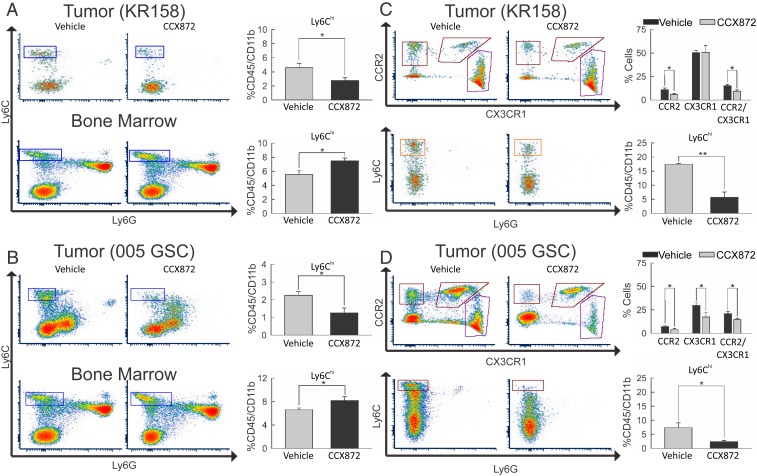Fig. 5.
Impact of combinatorial CCX872/anti-PD-1 treatment on peripheral and tumor myeloid cell populations. (A) Flow-cytometric analysis of Ly6C+ vs. Ly6G+ events in KR158 tumor isolates (Upper) and bone marrow cell populations (Lower) from vehicle-treated (n = 6) and CCX872-treated (n = 6) animals. Drug treatment resulted in a reduction (P = 0.038) of Ly6Chi events within tumors and an increase (P = 0.028) in bone marrow. (B) Flow-cytometric analysis of Ly6C+ vs. Ly6G+ events in 005 GSC tumor isolates (Upper) and bone marrow cell populations (Lower) from vehicle-treated (n = 6) and CCX872-treated (n = 5) animals. Drug treatment resulted in a reduction (P = 0.015) in Ly6Chi events within tumors and an increase (P = 0.028) in bone marrow. (C) Flow-cytometric analysis of tumor isolates from KR158 tumor-bearing Ccr2RFP/WT/Cx3cr1GFP/WT mice depicting CCR2+ vs. CX3CR1+ (Upper) and Ly6C+ vs. Ly6G+ events (Lower) from vehicle-treated (n = 5) and CCX872-treated (n = 7) animals. Drug treatment resulted in a significant reduction of CCR2+ (P = 0.024) and CCR2+/CX3CR1+ (P = 0.032) events. The lower graphs report a reduction (P = 0.004) in Ly6Chi events within tumors. (D) Flow-cytometric analysis of tumor isolates from 005 GSC tumor-bearing Ccr2RFP/WT/Cx3cr1GFP/WT mice depicting CCR2+ vs. CX3CR1+ (Upper) and Ly6C+ vs. Ly6G+ events (Lower) from vehicle-treated (n = 6) and CCX872-treated (n = 6) animals. Drug treatment resulted in a reduction of CCR2+ (P = 0.003), CX3CR1+ (P = 0.003), and CCR2+/CX3CR1+ (P = 0.0419) events. The lower graphs report a reduction (P = 0.020) in Ly6Chi events within tumors. Representative plots are shown throughout. *P < 0.05; **P < 0.01.

